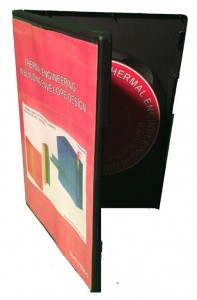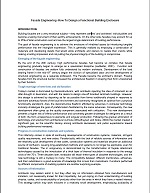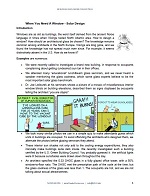Thermal Engineering in Building Envelope Design – Canned Seminar on DVD
Duration: The educational seminar runs for approx. 2-1/2 hours, (although your mileage may vary if you pause the show to read individual slides) running time plus introductions and presentations. The original source seminar consisted of 713 slides and was delivered at high rate of speed.
Comments: Seminar describes the means and goals of energy engineering with respect to building envelopes: heat transfer and condensation risk assessment procedures and presents the basic thermodynamics concepts with special focus on the areas typically overlooked by architects.
Target Audience: Kaz slanted it for achitects. For some reasons engineers seemed to be the most enthusiastic recipients among mixed attendance consisting of architects, contractors, code officials, etc. One architect”s comment summarized it well: “It was quite scary. You suddenly realize how much there is to know.” The most interested attendants tend to be Kaz’s competitors: building enclosure consultants, because Kaz shows the tricks of the trade.
Learning objectives: 1. LEED EA energy optimization credit and ASHRAE 90.1. Comparison between energy optimization and renewable energy source. 2. Basic components of thermal comfort, introduction to psychometrics. How heat is propagated – radiation, conduction, convection. 3. Measures of energy transfer – thermal transmittance, resistance, heat storage, emissivity, and convection. 4. Uniqueness of hot climate and basic condensation risk differences. Moisture transmission and accumulation, permeability of materials and diffusion, air leakage. 5. Condensation risk assessment, three dimensional thermal bridging, steady state and transient analyses, moisture migration analyses. 6. Case study of window in a precast concrete wall,. 7. Case study of a curtain wall bay. 8. Case study of an aluminum transom.
Table of contents
Curtain Wall Offset
Curtain Wall Transom
Window in Curtain Wall
Window In Precast Wall
Sloped Glazing Rafter
Trailer. We never produced a trailer for this DVD. However; we posted two case studies from this seminar free of charge online:
Case Study 1 – 3D Thermal Analysis of a Curtain Wall Bay (length 7 minutes) . This famous case of a structural curtain wall was also described in my article published in JBED in 2010, available for download at our old website.
Case Study 2 – 2D Thermal Analysis of a Mullion (length 11 minutes). This video describes the process of improvement of a horizontal mullion of a curtain wall, which was found substandard at the submittal stage. It shows a number of variations and their effects on the thermal performance.
Self Reporting Form: The old form is available for download. AIA spent our dues on frequent changes of their website, making it even less intuitive every time, so the specific steps had varied already by the time I was finished with the form. Please note that jurisdictions may vary with their acceptance of self-reported units, please check with your state first.
HSW: Yes, over 75% in 3 category: Salutary physical effects among users.
Sustainable Design: YES.
SD Categories that apply – Category VII. Energy Flows and Energy Future Sustainable design conserves energy and resources and reduces the carbon footprint while improving building performance and comfort. Sustainable design anticipates future energy sources and needs.
Topics: Conserving Systems and Equipment , Energy Modeling , Mass Absorption , Thermal Bridging, Windows and Openings
GENERAL DESCRIPTION: The seminars focus on areas typically overlooked by architects and engineers in process of building envelope design. The topics are chosen on basis of observations derived from both forensic investigations of failed assemblies and peer reviews of architectural documentation.
Version. It’s the first version recorded on DVD in year 2013. He never had the time to update this DVD. Kaz originally developed this seminar in year 2005, and delivered it in New York Cit in 2005. (He didn’t speak much English at the time). This video was based on the AIA 2030 Challenge seminar delivered in Columbus and served as a draft before the BEC Colorado seminar, so if you attended one of those two, you may recognize some remote similarities. At some point it was registered with AIA for learning units and the required AIA slides were added, please ignore them, as we no longer have time to report individual learning units.
Author: Overshadowed by his later accomplishments is the fact that Kaz worked as Energy Rater on over 200 buildings, many of them high rise, while getting his Masters in Architecture. (In his Greening Seminar you can hear him recalling some juicy stories from this period.) Later, he pioneered 3D thermal simulations in curtain walls. In this seminar, he is just trying to explain the basics to the architects.
Packaging: May vary. We will probably switch to cardboard sleeves soon.
Price: We also encourage a purchase of several DVDs at a discount.
How Can I get it? We sell them directly via the form below, as well as they will be available through third-party re-sellers soon.
If you plan to purchase, please approve the applicable terms and conditions. When you press the “Buy Now” button, you will be taken to the checkout webpage.
| Terms and Conditions |
|
Warning: Do NOT purchase unless you read and understood the terms and conditions that apply. Purchaser agrees to make the video available only to those individuals for whom a license has been purchased, otherwise heavy penalties would apply. You are purchasing a license or “right to view,” and the licensee must agree to the terms and conditions that apply to the purchase. We need to know the name and email address of each for each individual viewer/ licensee before we can complete your order (if you use Paypal, please place the information in the “comments” section to speed up the process). Time and Shipping. Orders are fullfilled within one week. First-class shipping by USPS to the continental U.S. is the default method of shipment. Contact us if you require overseas shipment. Taxes. Florida sales tax is added to the order. Updates: We no longer provide updates, regardless of whatever may be printed and said on them. Learning Units: We no longer provide them, regardless of whatever may be printed and said. Other Languages: Videos are available in English language only, but we will burn DVDs with subtitles in the most demanded languages. (Wideo bedzie na razie dostepne jedynie w jezyku angielskim, ale zrobimy napisy w innych jezykach w zaleznosci of zapotrzebowania.) Large Orders: Since Kaz ’s videos are useful for group viewing, pricing is set according to the total number of individuals who will view the video. Contact us if your party is larger than 10.
|


 Condensation Risk Assessment
Condensation Risk Assessment Facade Access
Facade Access Facade Engineering. How To Design a Functional Building Enclosure
Facade Engineering. How To Design a Functional Building Enclosure Facade Impact Resistance Manual
Facade Impact Resistance Manual Foggy Glass Disease
Foggy Glass Disease How To Write and Read a Forensic Report
How To Write and Read a Forensic Report Movements and Tolerances
Movements and Tolerances Review of Curtain Walls, Focusing on Design Problems and Solutions
Review of Curtain Walls, Focusing on Design Problems and Solutions Transitions: How to Design Facade Interfaces
Transitions: How to Design Facade Interfaces When You Need A Window – Solar Design
When You Need A Window – Solar Design
Leave a Reply
You must be logged in to post a comment.